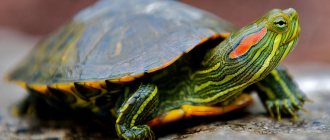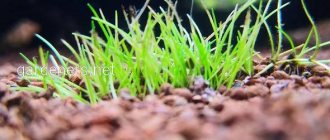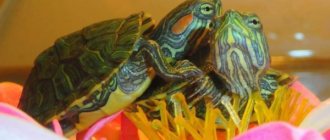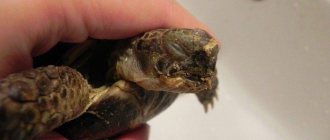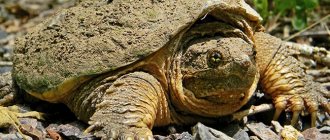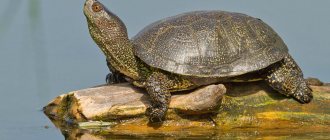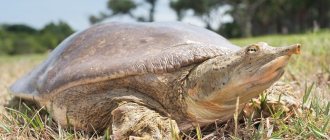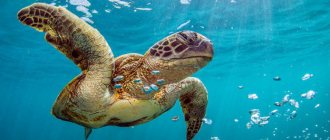Description and appearance
The maximum length of the shell of a red-eared turtle can be 35-40 centimeters, but when kept in captivity, the dimensions are significantly reduced and are about 13-27 centimeters. The “armor” of an amphibian consists of two parts: the abdominal plastron and the dorsal shell, called the carapace. The dorsal carapace, in turn, consists of three parts: vertebral, pleural and marginal shields.
All scutes consist of keratin elements, the arrangement of which forms a small elevation in the center. The color of the shell can change significantly as the turtle ages. As a rule, the main color of the carapace is considered to be dark green with dark or light stains. In young turtles, the shell is light green and as the amphibian matures it darkens, acquiring an olive green or brown tint.
The abdominal shell is almost always light yellow in color with dark irregular streaks in the center of the plates. The turtle's limbs and head are thin and green, complemented by irregular yellow stripes. In general, the color of the amphibian is ideal for camouflage in the natural environment.
The turtle's skeletal structure is complete and its feet are partially webbed, allowing it to swim. The signature feature of the red-eared slider is the presence of red stripes on each side of the head where the ears are supposed to be located. Over time, the stripes may lose color. In some specimens, instead of stripes, small red markings appear in the area of the crown.
Habitat of the red-eared slider
The turtle's natural habitats are the Mississippi River basin and the Gulf of Mexico region. The amphibian is also widespread in the southeastern part of the North American continent, as there is a favorable tropical climate there. According to scientists, the native territories of red-eared turtles are located between Florida and southeastern Colorado. In general, turtles prefer calm bodies of water with warm water. These can be slow-moving rivulets and streams, small lakes and ponds, as well as swamps.
In general, the amphibian prefers such bodies of water where there is the possibility of unhindered access to land for sunbathing. The fact is that the red-eared turtle does not have the ability to regulate body temperature due to physiological characteristics. That is, the animal’s body temperature directly depends on the ambient temperature. Quite often you can see amphibians climbing on top of each other and lying around in the sun. In nature, this type of turtle does not stray far from its native body of water, unless there is a need to change its place of residence or lay eggs.
Due to its high popularity as pets, the red-eared turtle has been released into the wild in various parts of the globe. Today, wild populations can be found in the Caribbean, Australia, southern Africa, Europe and the UK. Unfortunately, the spread of red-eared turtles around the world has some negative consequences for other relatives. The fact is that they often transmit diseases and displace other turtles from their original habitats.
What not to do during communication
If the owner does not want to lose contact with the pet, he should not turn it upside down.
In the wild, a reptile turns over on its back and dies unless other animals come to its aid. They are often rescued by elephants - if they are large individuals - or other turtles. The animal will not be able to assume its usual position on its own and will die of starvation.
Therefore, the instinct of self-preservation with such a radical change in body position signals mortal danger.
A person will never be able to accustom a reptile to such a “trick” - he will only turn the creature against himself. And then it will be impossible to establish contact: the animal’s memory will always be on guard: “You can expect death from this person!”
Do not tap the shell with a fingernail or pen. For an animal, such actions are equivalent to how a person would be knocked on the head. It's unpleasant and stressful.
What does a red-eared turtle eat in the wild?
In general, the red-eared turtle is an omnivore. The main part of the diet is plant foods, especially for adults. In its natural habitat, the turtle also feeds on worms, mollusks, small fish, tadpoles, aquatic insects and all kinds of algae.
Adult reptiles feed mainly on food of plant origin. Young turtles are considered predators, eating small insects and worms, small fish and tadpoles. In some cases, if there is a lack of food, the red ear can even feast on carrion. But despite the fact that adults prefer grass, they will never refuse a piece of meat.
It was noticed that the reptile perfectly adapts to almost any habitat it finds itself in. Numerous cases have been recorded in which the red-eared turtle adapted to brackish water, sewers, and ponds in urban areas without any problems. I would also note the fairly high survival rate of the reptile in the coldest winters.
How is the sex of an individual determined?
We found out how many teeth a turtle has. Now let's move on to determining gender. Red-eared turtles grow quite quickly. Animals reach sexual maturity by about a year. It is possible to determine the sex only when the individual reaches a size of more than 10 cm. More or less accurately determining the sex is possible only by 3-4 years if it is a male, and by 4-5 years if it is a female.
Females are usually larger than males and have a shorter tail. Also, their cloaca is located closer to the base of the tail. Males will have more curved and longer claws on their paws, and the lower abdominal part is slightly concave inward, making it easier for him to mate with a female.
Lifestyle in nature
On average, the lifespan of a red-eared turtle ranges from 20 to 40 years. Life expectancy is directly affected by habitat. The reptile spends most of its time in the water, periodically climbing out onto a stone or snag to warm itself. To maximize the absorption of solar heat and ultraviolet radiation, turtles extend their limbs.
Scientists have found that this species of turtle does not hibernate, replacing winter sleep with a kind of suspended animation. During periods of decreased activity, the red-eared slider rises for another breath of air or a snack. Wintering in nature takes place at the bottom of the reservoir. The animal's activity begins to decline when the water temperature drops below 10 degrees.
A decrease in ambient temperature leads to the fact that the turtle stops eating, moving, defecating, and breathing, roughly speaking, every other time. In regions with warmer climates, activity in winter may not decrease at all. During periods of brumation, red-eared turtles can survive without air for two to three weeks. During this process, the metabolic rate is significantly reduced, and the heart rate slows down by 80%.
Behavior, communication, everyday situations (summer, dacha, children, etc.)
The vocal cords of red-eared turtles are not developed. At the moment of threat, out of fear, they are capable of emitting a hiss or a thin squeak. You should not suddenly lower your hand on the turtle, make noise or gesticulate violently: it will mistake you for a predator and may begin to “defend” in panic: hiss, stick out its claws, try to hide in its shell, or bite. You will have an instinctive desire to recoil from the head of the angry animal and withdraw your palm.
At the same time, you should also be wary of the turtle’s hind legs - they also have sharp claws, and in a moment of danger, the animal may try to hit or push away its source using its hind limbs. This is especially dangerous when being carried or transported: if pushed, the turtle may fall to the floor and be injured. Therefore, do not trust a child who is too young to carry turtles from place to place for feeding or cleaning the terrarium.
The best way to let your pet breathe in the fresh summer air and bask in the sun is to place the terrarium outside. However, avoid direct sunlight so as not to overheat the animal, and also carefully monitor the terrarium so that it has some kind of lid or tightly closed lattice on top so that neither birds of prey nor dogs can get to the turtle. And it is better that such a “walk” takes place under your supervision.
In the warm summer, the diet of the red-eared turtle can be diversified with fresh dandelion leaves or lettuce, but only in small pieces, as a treat, without “breaking” its diet in order to avoid digestive disorders.
Contents in a home aquaterrarium
A red-eared turtle will live as long as possible in captivity only if comfortable living conditions are created for it. First of all, you need to choose the right terrarium. Considering the size of the reptile, the recommended volume of an aquaterrarium for an adult should be more than 100 liters. If in the case of an aquarium its height plays an important role, then with a terrarium the situation is somewhat different. Turtles need to provide a large bottom area. The water level in the tank should be such that the turtles can easily crawl out to some hill to take “sun” baths.
Approximately a quarter of the area of the turtle's home should be occupied by a hill with a sloping rise so that the pet can climb out of the water to rest. Large stones are welcome at the bottom of the terrarium. But you will have to discard living vegetation, because it will be eaten in the shortest possible time.
The second point that should be given special attention is water. In particular, it is not the hydrochemical composition that is important, but its temperature. In cool water, turtles will be lethargic and their metabolism will slow down so much that digestion will almost stop. Keeping pets in such conditions for long periods of time can lead to death. The optimal water temperature ranges from 25 to 28 degrees, and the atmosphere is 30 to 32 degrees.
During their life, turtles leave a lot of dirt behind, which will have to be removed regularly. Otherwise, the aquaterrarium can turn into a real swamp, only at home. First of all, it is necessary to organize high-quality filtration. This can be achieved by installing either an internal or external filter. In addition, you will have to do weekly water changes in the amount of ⅕ of the total volume. Replacements should be made together with a soil siphon, if available.
The next thing I would like to focus your attention on is a place to relax. You need to install a couple of lamps above the sushi island. The first is a regular incandescent heating lamp, which can be replaced with a special one for reptiles. The second lamp should have an ultraviolet radiation spectrum, which will promote the production of vitamin D in the turtles' body. In the absence of UV radiation for a long time, the red-eared turtle develops rickets and the shell softens. At night, the lights are turned off.
How to care for babies
They buy turtles when they are still babies. It is important to ensure that they eat well and are in a comfortable environment. Cubs have a high mortality rate, are exposed to various diseases and can die for no apparent reason.
If you notice something unusual on your baby turtle's shell, it could be the yolk sac, from which the hatchlings receive nutrients. You don't need to touch it. It will resolve itself after some time.
It is better not to hold babies in your arms, as they get very scared, become stressed and get sick. Also, do not knock on the glass of the aquarium; the cubs need several days to get used to the environment. It is important to maintain stable air and water temperatures during this time. The water should be at a temperature of 26-27 degrees, and the air at 32 degrees.
Red-eared slider compatibility
The best option is to set up a species terrarium. In practice, there are cases of keeping aquarium fish and turtles together. Teenage turtles will not be able to eat relatively large fish, which means that at first they will get along with the same cichlids. But the reptiles will grow up and their hunting instincts will awaken. Ultimately, the experiment of keeping fish and turtles together will end in failure.
Any familiar fish, such as guppies, cherry or Sumatran barbs, or everyone’s favorite red neons, will act as food. The red-eared turtle also does not get along with amphibians, namely newts, frogs and axolotls. The best option is to keep several red-eared turtles within one aquaterrarium. The main condition is that the terrarium must be spacious.
Epilogue
This article discusses the general rules for keeping red-eared turtles, which are suitable for all three subspecies.
Before getting a turtle, carefully weigh the pros and cons and think about whether you can provide the necessary conditions for keeping your pet healthy and not in need of veterinary care.
Remember: it is always cheaper and easier to properly maintain an exotic pet than to treat diseases that can be extremely dangerous in reptiles, particularly turtles.
Feeding in a home terrarium
At home, red-eared turtles are primarily fed specialized reptile food. I recommend paying attention to food from the manufacturer Tetra. If the pets are still young, then the main part of the diet should consist of protein foods. As reptiles grow older, the amount of plant food should prevail.
To keep the diet varied, it is recommended to feed turtles with low-fat sea fish or shrimp. Also, reptiles will never refuse to snack on aquarium snails (marises, melanias, coils). Plant food in a terrarium with turtles can include hornwort, riccia, duckweed or pistia. Also good are scalded lettuce and dandelion leaves, cucumber, apples and pumpkin. To strengthen the shell, place calcium blocks in the terrarium or feed with mineral supplements, such as Tetra ReptoCal.
Do turtles have teeth
Some breeders of red-eared turtles warn that the animal can bite. So how many teeth does a turtle have? In fact, they don't have teeth. They are replaced by incredibly durable horn plates.
The teeth of the land turtle, as well as other species, can even bite through the bones of small fish, and their bites are sometimes very powerful. If a turtle bites a person, he will feel pain and discomfort at the site of the bite. Moreover, the wound may become infected, since the turtle's mouth cannot be disinfected. The sea turtle has no teeth.
You may be interested in:What does the Earth look like from space - description, features and interesting facts
If such an unpleasant incident happens to you, the bite site should be urgently washed with a peroxide solution and treated with brilliant green or iodine. Sometimes a patch or tight bandage is required. If infection does occur, you should immediately consult a doctor.
Does a land turtle have teeth? In the photo you can see that they have no teeth, but only horny plates, like other representatives of this family.
Reproduction of the red-eared turtle
I want to say right away that breeding a red-eared turtle is an extremely labor-intensive process if done at home. A novice amateur is unlikely to be able to do this, since experience in this matter and special equipment are required. Individuals aged 5 years or more are selected for breeding. To form a pair for breeding, group housing in one aquaterrarium is necessary. In this case, there should be at least two females per male. The male differs from the female in the length of the tail and claws (in females they are shorter). In addition, males have a small depression on the plastron, while females have a bulge.
Turtles ready to mate, in particular males, regularly engage in fights, thus attracting the attention of females. The formed pair must be transplanted into a separate aquarium. You can stimulate turtles to mate by increasing the water temperature in the aquarium to at least 26 degrees, and also increasing the duration of daylight hours.
The female red-eared slider lays her eggs either in peat or wet sand. Before transplanting turtles into a separate container, a container with any of the listed substrates must already be prepared in it, laid in a layer of at least 5 centimeters. If there is none, females lay eggs either simply in the water or on an island of land. The maximum number of eggs that a female can lay is 10 pieces. The red-eared slider is not known for its caring behavior towards its offspring.
In order for the turtles to hatch from the eggs, they are transferred to an incubator in which the temperature is maintained between 28 - 30 degrees. At a temperature in the incubator of 27 degrees, mostly males are born. When the constant temperature rises above 30 degrees, it is mainly females. The incubation period of red-eared turtle eggs lasts 3 - 5 months. After hatching, turtles have a yolk sac for a few days. At first, hatched turtles are kept separately from their parents, because they can harm them.
Cleaning
The most unpleasant and difficult thing. During harvesting, the turtle must be transplanted into a specially equipped fish tank (there can be only one tank for feeding and temporary housing at the time of harvesting).
Cleaning is done once a week. In our case, a full treatment of algae and bacteria using antiseptics is required, followed by rinsing under running water. Chlorhexidine, sold at any pharmacy, is suitable as an antiseptic, or you can use a weak soap solution. During cleaning, do not forget to thoroughly treat each wall and all corners of the aquaterrarium.
Remember: provided that the aquaterrarium is thoroughly cleaned weekly, the likelihood of your turtle developing skin problems will be extremely, extremely low.
